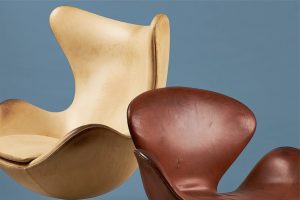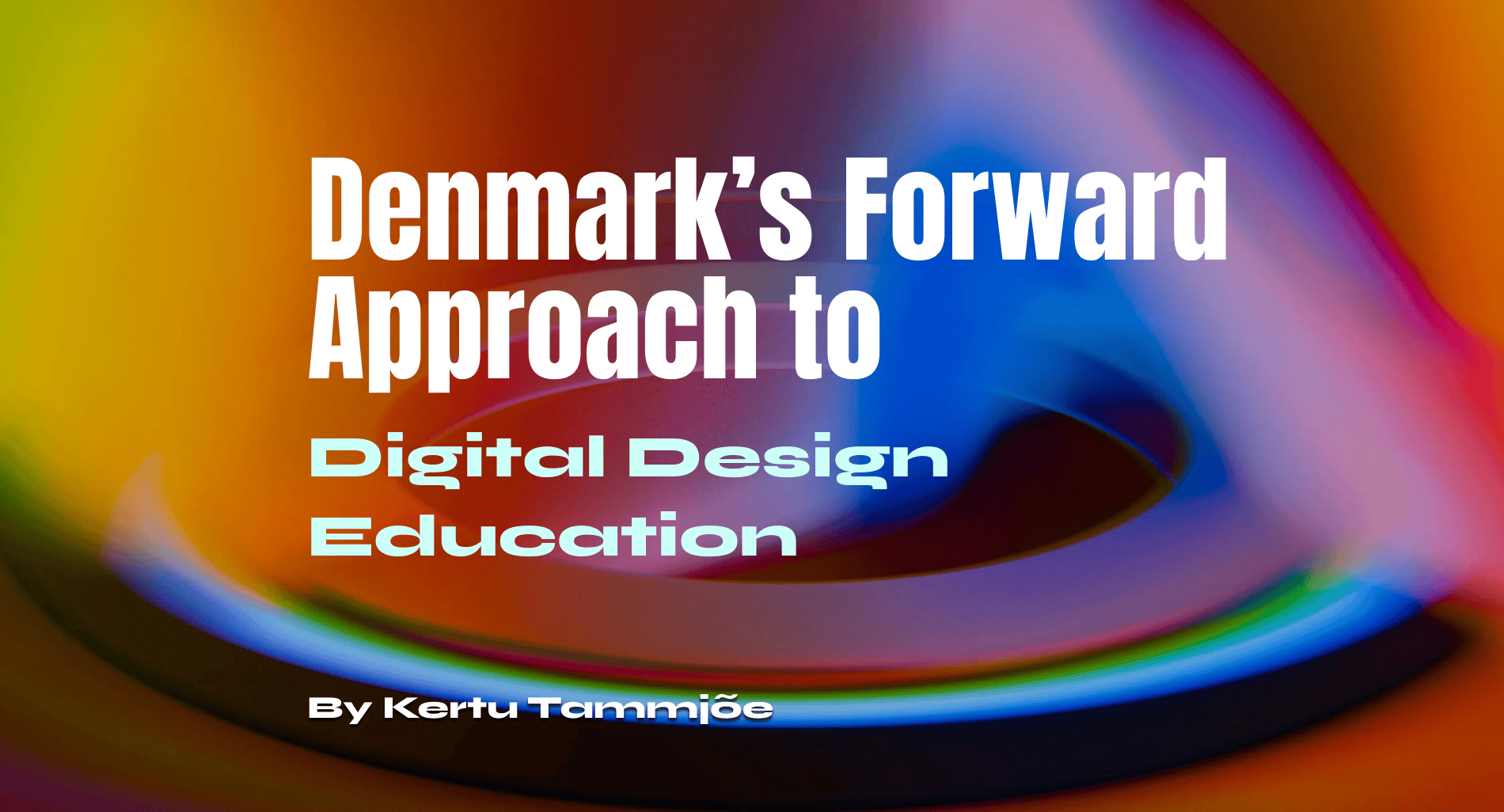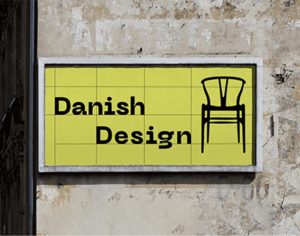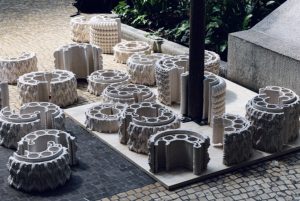When we try to define the digital designer of the future, whether we want to or not, we need to look at the process of becoming a designer. By integrating creativity, sustainability, and interdisciplinary approaches with cutting-edge technology, Denmark is redefining digital design education and reshaping what the competencies for the junior designers are.
The legacy of Danish design
To understand the development of design education in Denmark, it is essential to take a glimpse at the historical context; Danish design, which is characterized by simple lines, functionality, and a respect for craftsmanship, has long been celebrated. This has been highly applicable for traditional design practices like architecture, clothing, and furniture design. Some of the icons in these areas are Arne Jacobsen, Hans Wegner, and Kaare Klint, who all have established a legacy that has paved its way to people’s knowledge in Danish design.

The iconic Arne Jacobsen’s iconic The Egg and The Swan chairs
This heritage is not just a part of the past but is actively integrated into the educational framework, providing students with a strong foundation in traditional design principles while encouraging innovation and experimentation. With the boom of digitalisation which has made Denmark one of the most digitized countries in the world, the Danish digital design scene is paving its way among the largest world players.
Digital design specialization paths in Danish education
Danish design education is distinguished by its emphasis on creativity, sustainability, and interdisciplinary learning. Institutions like The Royal Danish Academy of Fine Arts, Design School Kolding, DMJX and VIA University College are pioneering new approaches that help to prepare the designer to enter the job market with confidence and skills from working on real-life cases and clients.
https://www.behance.net/search/projects/danish%20design%20school
The Danish higher education provides a range of courses and specializations that help to tweak the competencies of designers. Quite a few university colleges or academies offer additional design related courses for non-students enabling business, marketing or sales people to gain additional competencies. The electives enable the students to shape their skills. The options for education in English are more limited, but depending on the education length and level, the courses provide many different specializations, from Game Design to Designing for the Brain to Character Animation.
What do Danish schools do differently?
When we look intot what makes the Danish design education so unique, it’s best to also ask those who teach and create the learning programs. The Dean of Design at the Royal Danish Academy, Mathilde Aggebo, gave us some perspective on the topic from the educational institution’s side.
https://royaldanishacademy.com/en/kadk-exhibitions
How is the Academy addressing the rapidly changing landscape of digital design and technology?
Mathilde: The academy has a unique way of weaving the digital advancements into the subject fields. Based on the work by lecturers and researchers, the academy identifies trends and new technologies that are then incorporated into all of the courses in one way or another. Since the boom of 3D and AI, the academy has been obtaining new machines and equipment to enable the students to try them out and understand the concept in depth. The academy also has a close connection with many bigger companies that have access to the newest technologies and can also pitch in with new skill sets needed for all kinds of designers. Testing and trying out new ways makes the students design-doers. Giving them a great base when entering the job market.
https://royaldanishacademy.com/en/case/developed-surface
What makes the Royal Danish Academy stand out when it comes to the already globally known university teaching methods in the digital design industry? How do you encourage design students to get real life experiences during their studies?
Mathilde: “Most professional academies ,as well as the Royal Danish Academy, put a big emphasis on creating a workshop-based environment for the students. This means that there might be traditional lectures that give the base information of the course but the focus is set on group work and case based studies. Which gives the students an actual feel of what it means to execute a project and prepares them to take on tasks right from the start of the education and work. The Royal Danish Academy in particular has an artistic approach, which enables the students to get creative and try out new ways. This is one of the key factors that helps to set the students apart from a traditional error and fail method in universities.
The academy also puts a lot of focus on collaborating with external partners and companies that show the way of operations and introduce the daily work environment. The companies that the school works with inspire and encourage students to use more niche technologies and find comfort in discomfort. This also applies to other professional academies in Denmark. The internship, which is part of every design and digital design education, helps define the skills of the students and gives them the opportunity to gain experience with the bigger companies that have solid work plans and ways of doing things.
Something that Royal Danish Academy strongly believes in is that design is for everybody. No matter if digital, architectural or furniture, we need to and should want to design for everyone. The chairs should not be simply designed for a display window but they should also be designed for children in kindergarten, people in hospital and also challenged people. So it is clear that the designers entering the Danish market are bringing in a more decolonized design approach.”
You can read more about what decolonizing or anti-colonizing design means in an article by Cristina Cruz.
https://kglakademi.dk/da/galleri/adfaerd-og-velfaerd
My experience of the digital design education in Denmark
Having studied a Bachelor’s degree with the specialization in Digital Concept Development, I can say that the education system here gives you as much as you are willing to put into it. Yes, I did maybe spend less time with my head in the books, as most of the studying was done in study groups and included a very practical approach. On the other hand, coming from a Baltic rigid studying mindset, which was influenced by the Soviet mentality heavily, where students learn by heart, it was a refreshing but challenging alteration to the studying style.
More than before I faced working in teams, which meant finding your place in the design process and adjusting to working with multiple learning designers with many new ideas and perhaps skills that needed refining.
This style of education gave me a solid understanding of how the design process works in a real-life setting. If I had worked alone throughout my whole education, I would have not known what a true design process looks like before entering my first position, and could have potentially faced the fear of feeling misplaced. I managed to adjust the learning process to my liking, which hugely helped me find balance between researching and practice.
Exhibition of a digital storytelling project from the Bachelor education in Business Academy Aarhus.
Most importantly, I got to work with some significant companies and create full UX projects that were reviewed by the designers at the company. This gave me confidence, curiosity and interest in pursuing working with digital design, as I was given the trust to work with companies and cases that play a role on either Danish or global markets. It also meant getting familiar with the business side of the companies which can often lack in non-economics related education.
I think that the Danish system is really encouraging of trial and error methods of studying. Being hands on with all the cases helped to get the real feel of being a designer and the students were put under the condition which has pretty accurately met the conditions of a full-time working designer.
So should we all go study design in Denmark?
Well in all honesty, Denmark can give you a great hands on experience. You can work with many big names that are known in the field and can introduce you to company culture as well as realistic project management. The internships available during the studies can set a great base to make connections and get the valuable experience needed post graduation.
On the other hand, if you are more confident in books based learning and prefer your grades to be the outcome of solely your own efforts, the Danish education system might not be quite for you.















